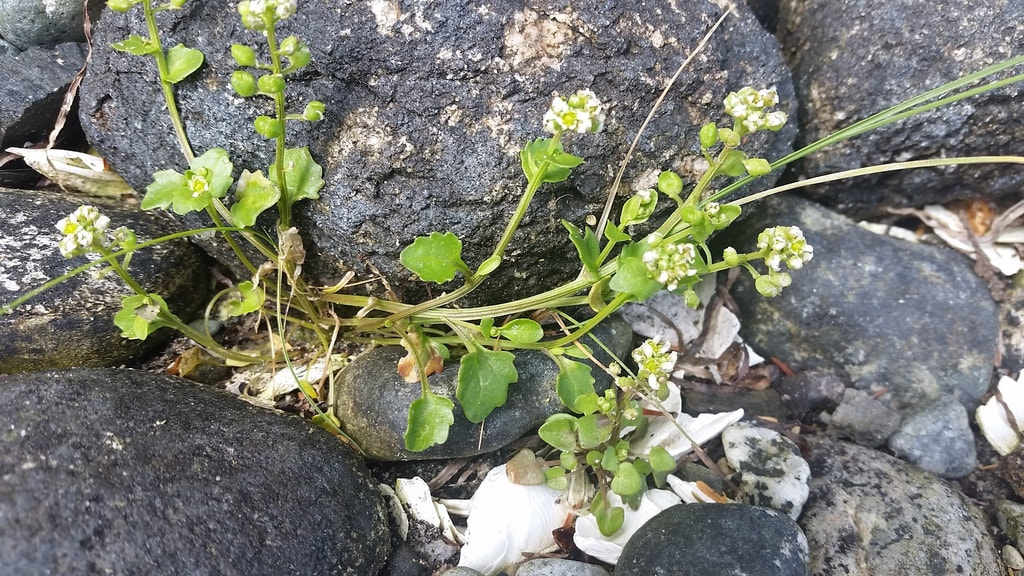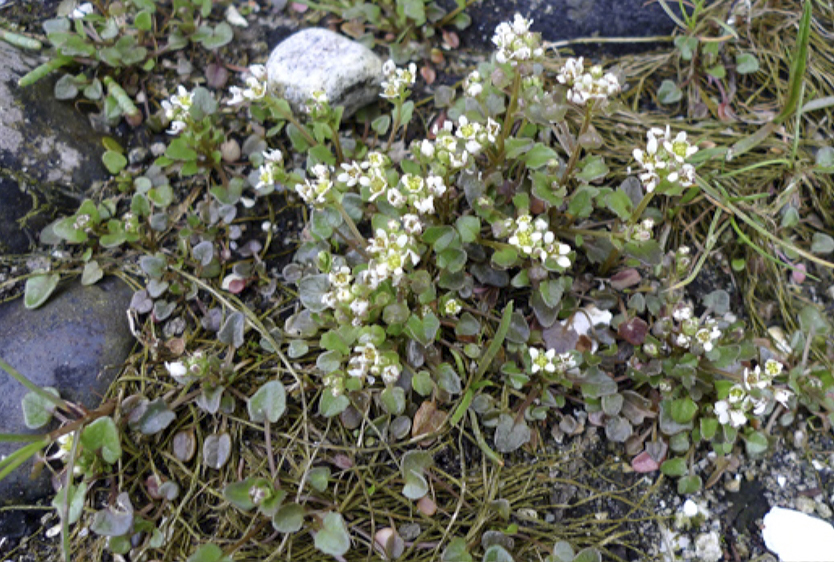Scurvy grass, common scurvy grass, spoonwort • Cochlearia groenlandica, C. officinalis ssp. groenlandica
{Cochlearia from cochlear = spoon}
|
Identification
Scurvy grass is a small, low-lying biennial or perennial plant. It is fleshy, with thick stems and leaves. The stems grow horizontally then curve up to vertical, reaching 30 cm long in total. The rounded leaves found at the base of the stems (basal leaves) are 2 cm long and grow in a rosette shape on stalks much longer than the leaves themselves. The leaves higher up on the stems (stem leaves) are more elongated and grow off short stalks or right from the stem. The flowers are white and small, with four petals reaching 0.5 cm long. Scurvy grass fruits are small rounded pods (silicles). |
Habitat & Range
Scurvy grass is a seashore plant commonly found along moist sandy shorelines, mudflats, and tidal marshes, at low elevations. Its range stretches from coastal Washington in the south through coastal BC to Alaska, the Yukon Territory, and Northwest Territories. It is also found throughout Eurasia.
Similar Species
There are many subspecies or species of the genus Cochlearia that fall under the name scurvy grass, and the physical characteristics of scurvy grass differ in response to different environmental stresses, which can make differentiation between different subspecies difficult. There also is some confusion about synonymous latin names for this species: the Illustrated Flora of British Columbia, published by the BC Ministry of Environment, lists it as C. groenlandica with C. officinalis ssp. oblongifolia as an alternative. E-Flora lists another 6 options. Luckily there is only once native Cochlearia species found in BC, so this naming and subspecies confusion should have no bearing on identification — in BC the names Cochlearia and scurvy grass will only refer to this one species.
Human Uses
Scurvy grass is edible, and received its name from the early Arctic explorers who packed dried scurvy grass to eat in the winter because it is rich in vitamin C. This one plant tended to make the difference between life and death from malnutrition exacerbated by scurvy. Sailors in other cultures, such as the British Navy in the 1700's, also used scurvy grass to the same effect.
While scurvy grass is indeed edible, there are different accounts as to its palatability. Some say it is quite bitter, while others say it is very tasty and makes delicious salads and sandwiches.
Intriguing Info
Danish scurvy grass (Cochlearia danica), a relative of C. officinalis, has begun to spread inland in Britain to the sides of salted roads. The salt, used to deal with icy conditions, causes most other plants to die off, and therefore clears the path for Danish scurvy grass to swoop in and take over.
iNaturalist
https://www.inaturalist.org/taxa/76403-Cochlearia-groenlandica
Scurvy grass is a seashore plant commonly found along moist sandy shorelines, mudflats, and tidal marshes, at low elevations. Its range stretches from coastal Washington in the south through coastal BC to Alaska, the Yukon Territory, and Northwest Territories. It is also found throughout Eurasia.
Similar Species
There are many subspecies or species of the genus Cochlearia that fall under the name scurvy grass, and the physical characteristics of scurvy grass differ in response to different environmental stresses, which can make differentiation between different subspecies difficult. There also is some confusion about synonymous latin names for this species: the Illustrated Flora of British Columbia, published by the BC Ministry of Environment, lists it as C. groenlandica with C. officinalis ssp. oblongifolia as an alternative. E-Flora lists another 6 options. Luckily there is only once native Cochlearia species found in BC, so this naming and subspecies confusion should have no bearing on identification — in BC the names Cochlearia and scurvy grass will only refer to this one species.
Human Uses
Scurvy grass is edible, and received its name from the early Arctic explorers who packed dried scurvy grass to eat in the winter because it is rich in vitamin C. This one plant tended to make the difference between life and death from malnutrition exacerbated by scurvy. Sailors in other cultures, such as the British Navy in the 1700's, also used scurvy grass to the same effect.
While scurvy grass is indeed edible, there are different accounts as to its palatability. Some say it is quite bitter, while others say it is very tasty and makes delicious salads and sandwiches.
Intriguing Info
Danish scurvy grass (Cochlearia danica), a relative of C. officinalis, has begun to spread inland in Britain to the sides of salted roads. The salt, used to deal with icy conditions, causes most other plants to die off, and therefore clears the path for Danish scurvy grass to swoop in and take over.
iNaturalist
https://www.inaturalist.org/taxa/76403-Cochlearia-groenlandica
References
(2013). Danish scurvy grass thrives in gritted road conditions. BBC Culture. British Broadcasting Corporation. Accessed 27/06/2013.
Aiken, S.G., Dallwitz, M.J., Consaul, L.L., McJannet, C.L., Boles, R.L., Argus, G.W., Gillett, J.M., Scott, P.J., Elven, R., LeBlanc, M.C., Gillespie, L.J., Brysting, A.K., Solstad, H., and Harris, J.G. (2007). Flora of the Canadian Arctic Archipelago: Descriptions, Illustrations, Identification, and Information Retrieval. NRC Research Press, National Research Council of Canada, Ottawa. Accessed 27/06/2013.
Cochlearia groenlandica L. In Klinkenberg, Brian. (Ed.). E-Flora BC: Electronic Atlas of the Plants of British Columbia. Lab for Advanced Spatial Analysis, Department of Geography, University of British Columbia, Vancouver. Accessed 27/06/2013.
Douglas, G.W., Meidinger, D., and Pojar, J (Eds.). (2001). Illustrated flora of British Columbia. (Vol. 2). Victoria, BC: Ministry of Sustainable Resource Management and Ministry of Forests, Province of British Columbia. P. 118.
Genus Cochlearia. iNaturalist.org. Accessed 27/06/2013.
Scottish scurvygrass (Cochlearia officinalis subsp. scotica). ARKive.org. Accessed 27/06/2013.Pojar, J. and MacKinnon, A. (1994). Plants of Coastal British Columbia, Revised. Vancouver, BC: Lone Pine Publishing. P. 153.
Authors and editors
Kelly Fretwell and Brian Starzomski (2013).
(2013). Danish scurvy grass thrives in gritted road conditions. BBC Culture. British Broadcasting Corporation. Accessed 27/06/2013.
Aiken, S.G., Dallwitz, M.J., Consaul, L.L., McJannet, C.L., Boles, R.L., Argus, G.W., Gillett, J.M., Scott, P.J., Elven, R., LeBlanc, M.C., Gillespie, L.J., Brysting, A.K., Solstad, H., and Harris, J.G. (2007). Flora of the Canadian Arctic Archipelago: Descriptions, Illustrations, Identification, and Information Retrieval. NRC Research Press, National Research Council of Canada, Ottawa. Accessed 27/06/2013.
Cochlearia groenlandica L. In Klinkenberg, Brian. (Ed.). E-Flora BC: Electronic Atlas of the Plants of British Columbia. Lab for Advanced Spatial Analysis, Department of Geography, University of British Columbia, Vancouver. Accessed 27/06/2013.
Douglas, G.W., Meidinger, D., and Pojar, J (Eds.). (2001). Illustrated flora of British Columbia. (Vol. 2). Victoria, BC: Ministry of Sustainable Resource Management and Ministry of Forests, Province of British Columbia. P. 118.
Genus Cochlearia. iNaturalist.org. Accessed 27/06/2013.
Scottish scurvygrass (Cochlearia officinalis subsp. scotica). ARKive.org. Accessed 27/06/2013.Pojar, J. and MacKinnon, A. (1994). Plants of Coastal British Columbia, Revised. Vancouver, BC: Lone Pine Publishing. P. 153.
Authors and editors
Kelly Fretwell and Brian Starzomski (2013).






